Overview
The Mississippi River Headwaters dams, located in north central Minnesota, were constructed and placed in operation between 1884 and 1912. Maj. General Warren, the first St. Paul District commander, noted the importance of the Mississippi River Headwaters area during field surveys in the 1860s. Less than 10 years later, Congress authorized a feasibility study to determine whether a series of dams and reservoirs could aid in stabilizing water flow in the Mississippi River between St. Paul, Minnesota, and Prairie du Chien, Wisconsin. As a result, a system of dams capable of raising water levels and storing annual spring runoff from six existing lake systems was designated. These structures are located at the outlets of Gull Lake, Leech Lake, Big Sandy Lake, Cross Lake, Pokegama Lake and Lake Winnibigoshish. Two of these lakes, Leech and Winnibigoshish, are located within the Leech Lake Indian Reservation.
This reservoir system served its purpose well until the 1930s, when construction of the locks and dams below Minneapolis was completed and demand for supplemental water flow was greatly reduced. Today, the dams and reservoirs provide limited flood control, produce a natural environment for fish and wildlife and are a key link in the recreational and economic life of the area. Recreational opportunities have been provided for in one form or another since the early 1900s. However, official recreational facilities weren't provided until 1964, when recreational development master plan was established for Pine River Reservoir (Cross Lake). Recreational facilities continue to be upgraded and developed at each of the Headwaters sites.
Dam operation and recreational operations management goals and objectives are met through cooperative agreements and associations with other federal, state, local and private organizations.
History of the Pine River Dam
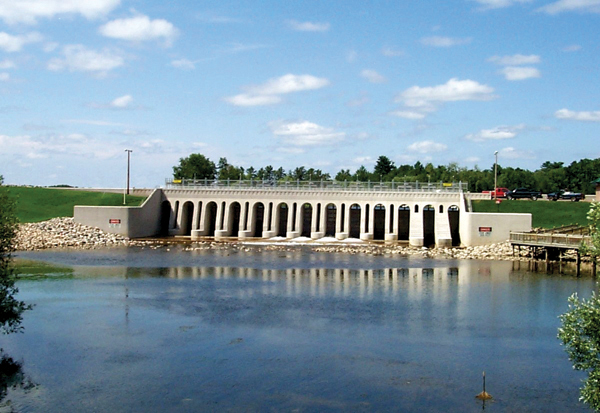 The Pine River Dam is located on the Pine River, at the outlet of Cross Lake, 15 miles above the junction of the Pine and Mississippi rivers. Pine River was the fourth Headwaters reservoir to be constructed. The original timber dam dates from 1884 and was put into operation in 1886. Corps engineers reused machinery and supplies from the construction of the Winnibigoshish and Leech Lake dams at this site.
The Pine River Dam is located on the Pine River, at the outlet of Cross Lake, 15 miles above the junction of the Pine and Mississippi rivers. Pine River was the fourth Headwaters reservoir to be constructed. The original timber dam dates from 1884 and was put into operation in 1886. Corps engineers reused machinery and supplies from the construction of the Winnibigoshish and Leech Lake dams at this site.
The dam was reconstructed to its present appearance between 1905 and 1907. The control structure is 233 feet in length and consists of reinforced concrete supported on timber piles. There are 13 sluiceways. A log sluice and fish way are no longer in use. A series of perimeter dikes built around the dam between 1899 and 1914 allowed it to be filled to capacity. In 1934, representatives of the Portland Cement Association reported that the Pine River Dam was the "finest concrete structure from the point of view of durability that they were aware of." The arched openings of the Pine River Dam give it a distinctive appearance. There are no structures remaining from the 17- building complex constructed by the Corps of Engineers in 1884. Included were a dam tender's dwelling, quarters, engineers' quarters, a dining hall, an office building, an officers' house, a woodshed, a chicken coop, a barn, a warehouse, a sawmill, a carpenter and blacksmith shops. The Corps removed a number of these buildings immediately after the dam construction was finished. A new dam tender's dwelling built in 1911 was later destroyed by fire in 1959 and was not rebuilt.
History of the Gull Lake Dam
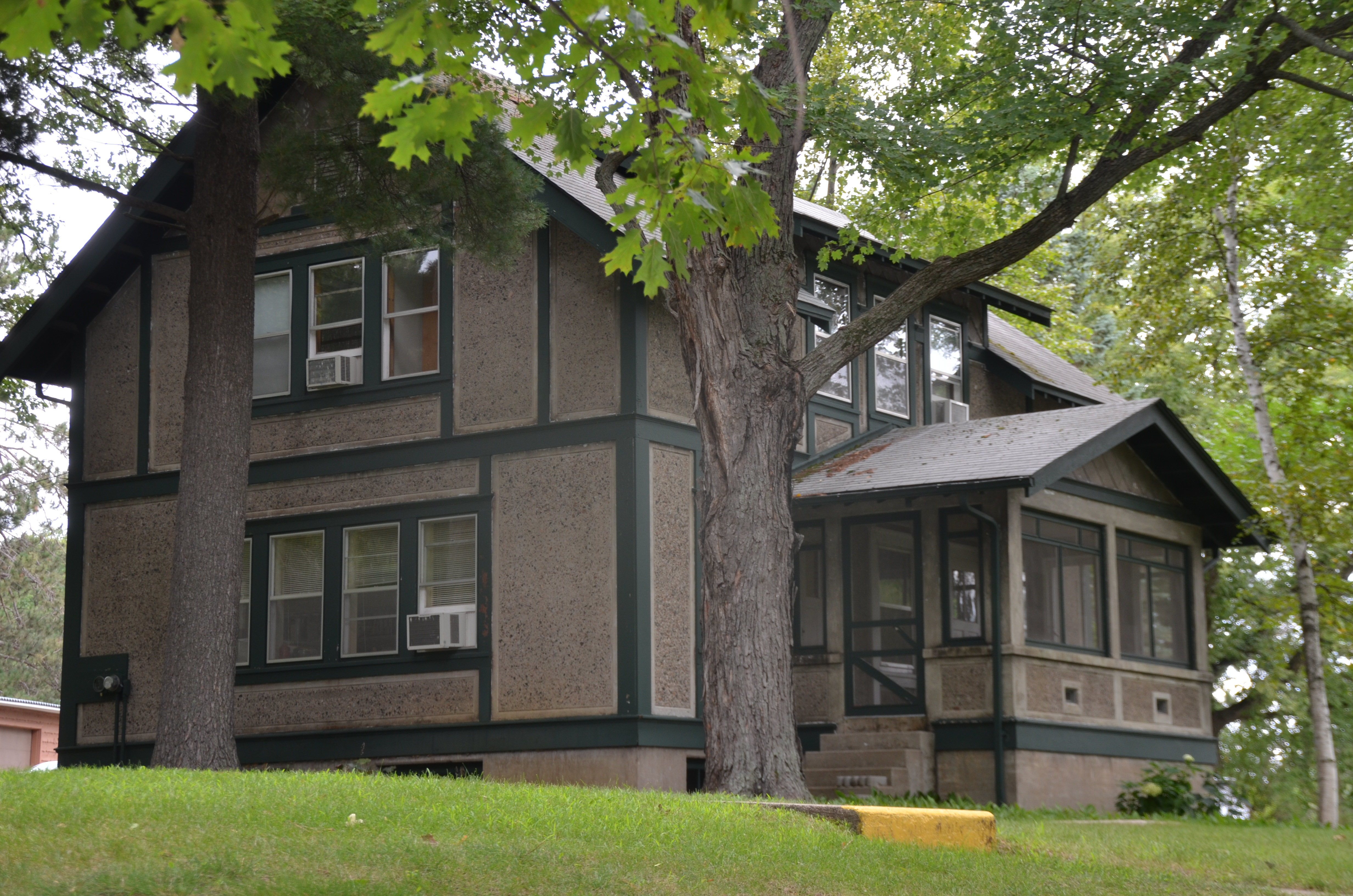 The Gull Lake Dam is located on the Gull River about a half mile below the outlet of Gull Lake. It was put into service in 1912, the last of the Headwaters reservoir dams constructed. The designers were Col. Francis R. Shunk and George Freeman. This team also designed Lock and Dam No. 1 on the Mississippi River between Minneapolis and St. Paul in 1917.
The Gull Lake Dam is located on the Gull River about a half mile below the outlet of Gull Lake. It was put into service in 1912, the last of the Headwaters reservoir dams constructed. The designers were Col. Francis R. Shunk and George Freeman. This team also designed Lock and Dam No. 1 on the Mississippi River between Minneapolis and St. Paul in 1917.
The control structure is built of reinforced concrete supported on timber piling. There is a log sluice, five sluiceways and a 5-foot fish way which is not useable.
The seven-room dam tender's house, completed in 1912, is of concrete and beam construction. The exterior is finished with concrete panels. It is a good example of the then popular "Craftsman" style of architecture. One characteristic of the style is its "honest," straightforward treatment of materials. Brick, stucco and frame Craftsman style houses were built in many Minnesota cities and towns between about 1905 and 1920. The exposed rafter ends at the eves, grouped windows, and simple board trim are notable details associated with this style. The dam tender's house is eligible to be listed on the National Register of Historic Places.
The prehistoric archaeology of the Gull Lake dam site is of particular significance. There are 12 complete and several partial burial mounds, representative of the Woodland Culture that established permanent villages in this area about 800 B.C. - A.D. 200 and A.D. 600 - 900. Archaeologists have studied the burial site and an interpretive center provides information for visitors. The burial mounds are listed on the National Register of Historic Places.
History of the Leech Lake Dam
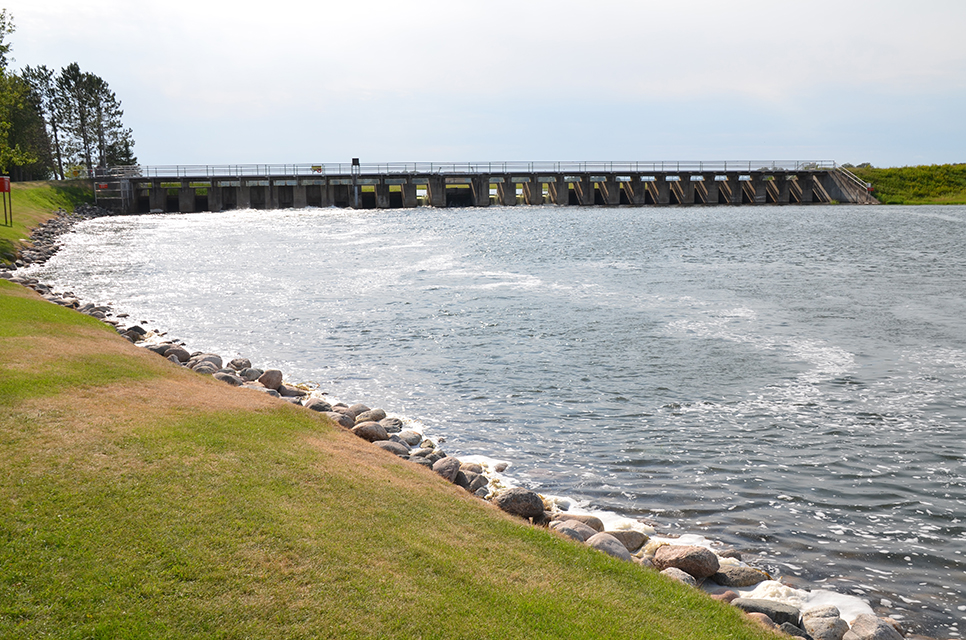 The Leech Lake Dam is located on the Leech Lake River at the outlet of Leech Lake. It is 27 miles above the junction of the Leech Lake River and the Mississippi River. Begun in 1882, the dam was the second to be constructed in the Headwaters Reservoir system. It was put into operation in 1884. The riverbanks are about 3,500 feet apart at the dam site, the largest span in the system.
The Leech Lake Dam is located on the Leech Lake River at the outlet of Leech Lake. It is 27 miles above the junction of the Leech Lake River and the Mississippi River. Begun in 1882, the dam was the second to be constructed in the Headwaters Reservoir system. It was put into operation in 1884. The riverbanks are about 3,500 feet apart at the dam site, the largest span in the system.
Between 1900 and 1903, reinforced concrete was used to replace the timber abutments and bays. The present 294-foot control structure consists of reinforced concrete abutments and piers supported by timber pilings. There are 25 6-foot sluiceways, one 12-foot log sluice, and one fish way.
The Leech Lake dam tender's house was built between 1902 and 1904. The dwelling is oriented north, with a view of the dam and the marshes of Leech Lake. The building exterior is generally unaltered, although it was originally covered with narrow wooden clapboards. The garage at the rear dates from about 1910. The searchlight to the north of the house was installed during World War II, when the dams were carefully guarded as part of wartime security. There is another searchlight at Winnibigoshish.
A variety of seasonal businesses, such as bait shops and fishing boat rentals, occupy the floodplain along the outlet channel. The Corps first leased a part of the shoreline for a pubic launch spot in 1909.
History of the Pokegama Dam
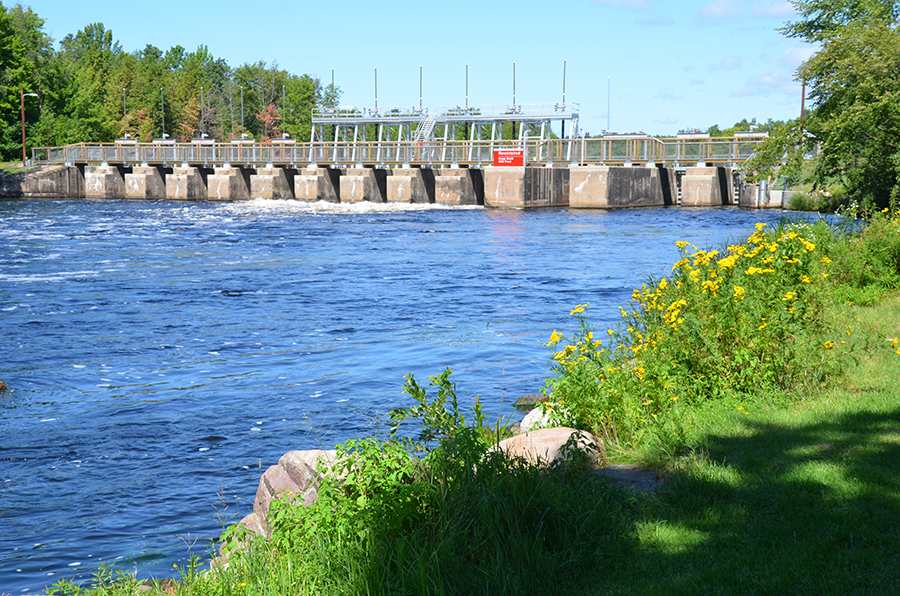 The Pokegama Dam is located on the Mississippi River, 3 miles upstream of Grand Rapids, Minnesota. Construction began at this site in 1882, and the dam was put into operation in 1885. The Corps of Engineers completed reconstruction in concrete in 1904. Pokegama is considered the distributing reservoir for the two upper reservoirs, the water from which passes through this dam.
The Pokegama Dam is located on the Mississippi River, 3 miles upstream of Grand Rapids, Minnesota. Construction began at this site in 1882, and the dam was put into operation in 1885. The Corps of Engineers completed reconstruction in concrete in 1904. Pokegama is considered the distributing reservoir for the two upper reservoirs, the water from which passes through this dam.
The current control structure is 225 feet long and contains 13 8-foot sluiceways and one 12-foot log sluice. The earth-filled embankments have timber diaphragms filled with puddle clay and rest on the quartzite outcrop that occurs in this area.
Eleven buildings were first erected at the start of construction of the original timber dam. In 1909, a temporary dam tender's dwelling was replaced with a 2 1/2-story dwelling that had plumbing and a hot air furnace, the first dam tender's dwelling to be so equipped at the time of construction.
A one-story office was constructed on this site in 1909. The stylish clapboard-clad building featured a flared hip roof and an eyebrow dormer.
History of the Sandy Lake Dam
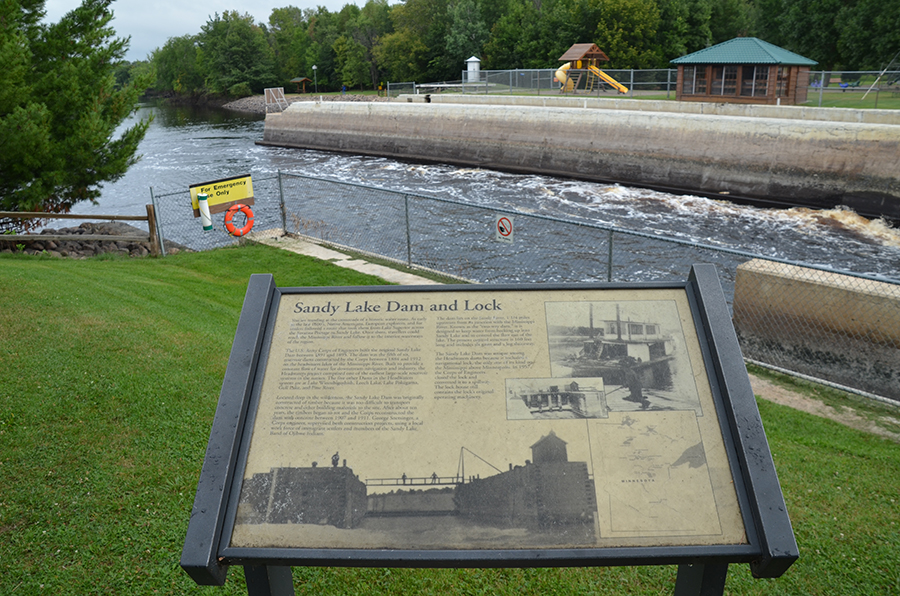 The Sandy Lake Dam is located on the Sandy River, 1 1/4 miles above the junction of the Sandy and Mississippi rivers.
The Sandy Lake Dam is located on the Sandy River, 1 1/4 miles above the junction of the Sandy and Mississippi rivers.
The original timber dam dates from 1892-1895. In 1896, a navigation lock, the only one in the Headwaters reservoir system, was completed. The original timber structure showed deterioration by 1904, and reconstruction began in 1908. Steamboats and horse-drawn wagons transported the concrete plant used at the Pine River Dam to this site. The lock was also reconstructed, and the operating machinery installed in 1912. The metal-sided shelter house was built over the machinery in 1914. The 30-foot-wide lock is no longer in use. In 1957, it was converted to a spillway containing 5 sluice bays.
Eight buildings were constructed at the beginning of work on the dam in 1892. In addition to the watchman's quarters there were a dining room and kitchen, a warehouse, carpenter and blacksmith shops, a tool house, a stable, and laborers' quarters. Conversion of the watchman's quarters into a dam tender's house began about 1910. The house was razed in 1991.
This dam site was near the terminus of the Savanna Portage, which connected Sandy Lake and the Upper Mississippi River with the St. Louis River and Lake Superior. Explores, fur traders and missionaries used the portage between 1755 and 1855. In 1794, to the south of the dam site at Brown's Point on Big Sandy Lake, the Northwest Company established a fur trading post. In 1830, the American Fur Company established a post at Sandy Lake at the junction of the Mississippi and Sandy Rivers, just to the west of the present dam. William Aitkin, the operator, and several missionaries resided here between about 1832 and 1855. A steamboat landing at this site operated after about 1870, bringing supplies and settlers to the area.
Fredrick Ayer established a mission and school near the dam site in 1832-33. A later school building stood northwest of the dam. It was moved off the dam site in the 1950s but a rubble foundation remains. A cemetery containing the graves of Indians and early settlers is found on the small hill near the site of the dam tender's house.
History of the Winnibigoshish Lake Dam
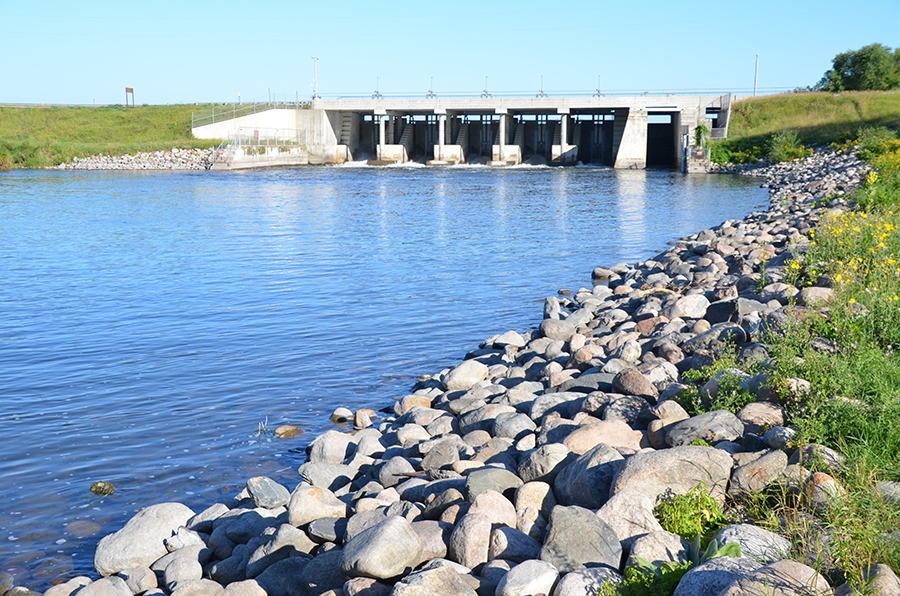 The Winnibigoshish Lake Dam is located on the Mississippi River at the outlet of Lake Winnibigoshish. This is the largest reservoir in the system; it controls the runoff from a 1,442-square-mile drainage area containing 28 lakes.
The Winnibigoshish Lake Dam is located on the Mississippi River at the outlet of Lake Winnibigoshish. This is the largest reservoir in the system; it controls the runoff from a 1,442-square-mile drainage area containing 28 lakes.
The Corps began construction of the original timber dam at "Winni" in 1881. It was put into operation in 1884. Nearly 2 million feet of white and Norway pine cut from the lakeshore were employed in construction of the pilings, dams and other structures. Logging operations, labor and material shortages, weather problems and the difficulties of constructing roads and installing machinery in near-wilderness conditions caused construction delays. The project employed 300 skilled and unskilled laborers, including local Chippewa Indians. In 1882, the Corps of Engineers announced that "the Winnibigoshish Dam is the inauguration of the reservoir system for the entire country."
The present concrete structure was constructed between 1899 and 1900. Stop logs divide 5 13-foot sluiceways into 3 sections. A 12-foot log sluice and a 5-foot fish way, the latter constructed in 1912, are no longer in use.
During the first phase of dam construction, workmen built 17 buildings across the channel to the west, opposite the present site. All of the buildings were of log construction. A map of 1883, made by Capt. Thomas Allen, shows the Corps headquarters and the nearby location of an Indian village and burial mounds. At the time of dam reconstruction between 1899 and 1900, the complex of buildings was also reconstructed at the opposite side of the dam.
Of special note is a prominent prehistoric linear burial mound located east of the present Corps maintenance building. Also, the Winnibigoshish Dam was listed on the National Register of Historical Places in 1982.